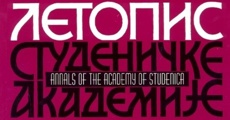|
|
10th
International Inter University Scientific Meeting
Academy of Studenica
PERSPECTIVES
IN MELANOMA MANAGEMENT
& NANOTECHNOLOGY IN BIOMEDICINE
Organizers:
Institute of Oncology
Sremska Kamenica; Union of Cancer Prevention
Societies of Vojvodina, Novi Sad; Clinic of Oncology, Nis; Institute
for Oncology and Radiology of Serbia, Belgrade Center for Bioengineering,
Faculty of Mechanical Engineering, University of Belgrade
President:
Vladimir Baltic Vice-presidents: Zlata
Janjic, Radan Dzodic, Borislava Nikolin; Djuro Koruga
|
|
|
| |
FULLERENOL
INHIBITS ANTITUMOR DRUG-INDUCED CYTOTOXICITY
Bogdanović G, Kojić V, Jakimov
D, *Đordević A, **Čanadanović-Brunet J, *Vojinović-Miloradov M.
Institute
of Oncology Sremska Kamenica, Novi Sad, Serbia and Montenegro
* TEMPUS Centar, University of Novi Sad, Novi Sad, Serbia and
Montenegro
** Faculty of Technology, University of Novi Sad, Novi Sad, Serbia
and Montenegro
|
|
| |
ABSTRACT
Background:
Polyhydroxylated fullerene C60 derivatives - fullerenols, have attracted
much attention due to their numerous biological activities. The
effects of fullerenol in biological systems are mostly based on
their antioxidative and free radical scavenging activities. Antitumor
drugs-related general toxicity is mainly attributed to oxygen-free
radical production. This paper presents the effects of the newly
synthesized fullerenol, C60(OH)22, on the growth of tumor cells
in vitro and its modulating activity on doxorubicin, cis-platin,
taxol or tiazofurin-induced cytotoxicity in human breast cancer
cell lines.
Methods: Cells were treated for two hours with fullerenol
alone (0.5-7.9µg/ml) or in combination with antitumor drugs (IC50
concentrations). Growth inhibition was evaluated after 24, 48 and
96h by colorimetric SRB or tetrazolium WST1 assays.
Results: Fullerenol induced cell growth inhibition at a
range of nanomolar concentrations in cell line, dose and time dependent
manner. Fullerenol also strongly suppressed antitumor drug-induced
cytotoxicity. The rate of cytotoxicity inhibition depended on fullerenol
concentration, type of antitumor drug and cell line. Fullerenol
inhibited cytotoxic activity of doxorubicin by more than 50% and
cis-platin cytotoxicity by more than 30% for both cell lines at
all concentrations. The rate of inhibition of tiazofurin cytotoxicity
was much lower on MCF7 (<30%) as compared to MDA-MB-231 cell line
(47%-61%). Taxol cytotoxicity was not reduced by fullerenol on MCF7
cells, while the same drug combination reduced cytotoxicity on MDA-MB-231
by 4.39%-26.97%.
Conclusion: Fullerenol C60(OH)22 modulated cytotoxic effects
of antitumor drugs in a different way. The protective effect of
fullerenol was found to be more pronounced against doxorubicin and
cis-platin cytotoxicity - antitumor drugs whose general toxicity
is related to free radical formation. Reduced cytotoxicity of taxol
and tiazofurin indicated that fullerenol protective effects might
be mediated by mechanisms other than antioxidative and hydroxyl-radical
scavenging activity. |
|
| |
Keywords:
Doxorubicin; cis-platin; Tiazofurin; Taxol; Fullerenol (non-MeSH);
Tumor Cell, Cultured; Toxicity Tests; Hydroxyl Radical; Free Radical
Scavengers |
|
|

